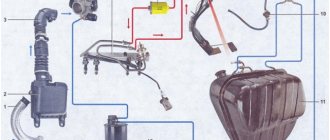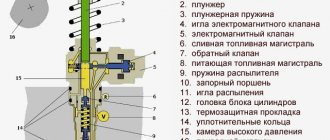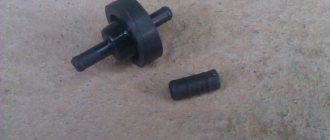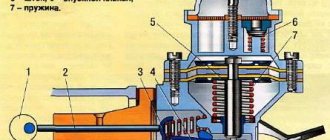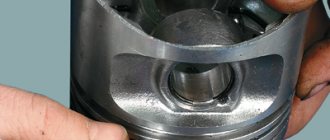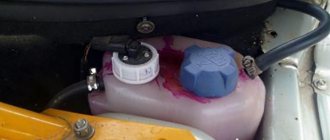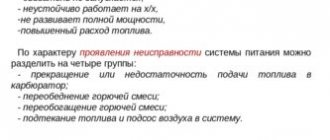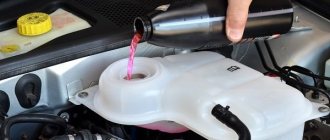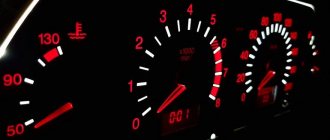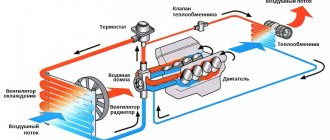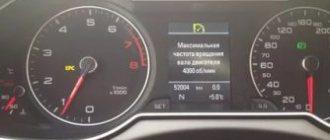Many vehicle components require periodic inspection and cleaning. The fuel system is no exception, so contamination is not uncommon. Most often, the cause of this problem lies in the use of low-quality fuel and poor sealing of the system, which provokes the appearance of oxygen or water oxides. Regardless of the factor that precedes the general breakdown of the fuel system, it must be periodically cleaned and done correctly. We will talk in more detail about the procedure for flushing car fuel lines and the features of this procedure in the article presented today.
A few words about cleaning the fuel system
Cleaning or flushing the fuel system is a procedure that is required at some intervals for all vehicles. Their operation in poor environmental conditions (especially urban) and the use of poor fuel negatively affect the internal condition of the fuel lines; in addition, moisture cannot be excluded. Driving a car with a clogged fuel system not only causes considerable discomfort, but also significantly reduces the life of the engine. In order to prevent this, it is necessary to promptly and correctly flush all elements of the system - from the tank to the injectors or jets of the distribution mechanisms.
Normally, fuel lines should be cleaned every 10-20,000 kilometers. If during the operation of the car the washing regulations were violated, then the need for cleaning should be determined by the behavior of the car. In most cases, a clogged fuel system forces the vehicle to:
- work poorly at idle;
- increase fuel consumption;
- lose in dynamics and acceleration;
- display an error indicator in the operation of fuel units on the on-board computer or control panel.
Of course, unstable machine operation is an unpleasant phenomenon. However, in such a situation, it is important to look deeper and understand that the lack of timely and proper flushing of the system will negatively affect the engine cavities. As a result, instead of a cost-effective cleaning procedure, you will have to pay for expensive engine repairs. Naturally, any motorist will not like this outcome of events, so it should not be allowed.
Application
New Suprotek packaging.
Suprotec gasoline additive is recommended for use in the following situations:
- problems with starting the internal combustion engine;
- excessive vibration;
- uneven engine operation;
- reduction in power.
Also, the fuel additive can be used when the car requires cleaning the injector (or carburetor) and injectors or cleaning the power system as a whole. The drug can also be used as a mild engine flush to eliminate deposits on fuel system parts and prevent the appearance of new ones.
In the event that contamination of the power system has not caused irreparable mechanical damage to the unit, the use of Suprotec Aprohim Sga on an ongoing basis over a period of 3,000 to 7,000 km can restore the performance of the injectors and contact surfaces, returning the vehicle to factory specifications.
Washing methods
Flushing the fuel system of a diesel engine is not much different from a similar procedure, but carried out on a gasoline unit. Taking into account this feature of cleaning measures, we will not separate the types of motors, but will consider all operations in a generalized version.
The first thing worth noting is the versatility of the concept of cleaning the fuel system. Today, the name of this procedure can be understood as both preventive flushing of components with special additives and high-quality cleaning of all system elements using flushing equipment. In order for every reader of our resource to understand the essence of such procedures, we will pay attention to various ways of their implementation. After analyzing all the washing options, we were able to identify three main ones:
- The first method is the use of fuel system cleaners, otherwise called additives. This approach has an average cleaning effect, so it cannot be used for heavily contaminated fuel systems. As a rule, additives are used for preventive cleaning of components every 10-15,000 kilometers. This method of washing is extremely primitive and requires little time and money. To implement it, just pick up a cleaning agent in the store and, following the instructions, pour the required amount into the tank after refueling. During the further operation of the car, the additive will clear all fuel paths, after which the fuel additive will burn along with it in the “engine”;
- The second method is the use of special equipment available at the service station (high pressure fuel pump, abbreviated as “HSVD”). This method is more time-consuming and cost-intensive, but has the highest cleaning quality. Its essence is that at a service station a solvent apparatus is connected to the fuel system of the car, which, by applying pressure with compressed air and a special substance (solvent), will flush the entire system. Note that flushing equipment does not allow cleaning the fuel tank, so to flush it you will have to resort to other methods. Diesel owners often use the hardware cleaning method, since the specificity of the fuel system of these vehicles allows them to get the maximum effect from the equipment;
- And the third method is thorough flushing by manually disassembling the system. This method is used in two cases: the first - if previously carried out flushes do not produce results and the engine continues to operate intermittently, the second - if there is a need to thoroughly flush the system to further maintain its condition using additives. The essence of this technique is to disassemble the fuel system element by element and clean each of them separately (blow, rinse in gasoline or diesel fuel, replace). Perhaps, manual washing is most widespread on injection engines due to the specific operation of injectors that require frequent cleaning.
Fuel system cleaner
High pressure fuel pump
Washing after manual disassembly
It is advisable to use the described methods for cleaning the fuel system in the following order:
- Hardware flushing;
- If there is no result, manual cleaning;
- After this, maintain the obtained result with flushing liquids.
We strongly do not recommend changing the presented order, since a different organization of flushing will negatively affect the fuel system, further worsening its condition.
Instructions for use
Suprotek fuel system cleaner is quite easy to use. First of all, you need to decide on the dosage of the drug. 1 bottle of 50 ml is designed for 40-60 liters of gasoline. For other filling volumes, proceed from the proportion of 1 ml of product per 1 liter of fuel.
If the car's mileage is over 50 thousand km, then during the first couple of refuelings it is recommended to use a double dose, that is, 100 ml of the substance per 40-60 liters of gasoline or 2 ml of the product per 1 liter of fuel.
To add an additive to gasoline, you need to follow the following algorithm:
- Shake the bottle vigorously until the sediment is completely dissolved in the carrier.
- Pour the additive into the tank.
- Fill the car with gasoline.
The vehicle can then be operated as usual.
Tank additive rating
Now that we have understood the essence of flushing the fuel system of a gasoline and diesel engine, let’s consider the best additives to maintain the obtained result. First of all, let's pay attention to the nature of cleaning products. Most additives are a high-quality product that cleans the fuel system of contaminants and moisture, and also removes carbon deposits from spark plugs and engine walls. However, some cleaning products more than once contained substances harmful to automobile parts (benzene, metals). Naturally, the use of such additives can seriously harm the car.
In order to prevent such an outcome, it is extremely important to choose the right product for cleaning the fuel system. After conducting a lengthy analysis of reviews from car owners and car experts about car additives in the tank, our resource has identified 5 products that can be guaranteed to trust the health of the car. The best cleansing additives included:
- 1st place – Suprotek and Liqui-Moly. Cleaning products from these manufacturers have proven to be the best, judging by reviews on the Internet. These additives work well both in terms of flushing the fuel system and for cleaning carbon deposits from spark plugs and in the combustion chamber. Over the course of numerous experiences using products from Suprotek and Liqui-Moli, not a single person has identified a negative effect of additives on their car. Moreover, the cleaning fluids are so good that it takes only 40-60 kilometers to see the first effect of cleaning. For other cleaning products, this requires from 70 to 150 kilometers. Note that the additives presented are available for all types of fuel (from gasoline to gas) and cost between 400-500 rubles;
- 2nd place – High-Gir. Cleaners from this company also perform well, but in terms of cleaning the fuel system, combustion chamber and intake valves, they are noticeably worse than the representatives of the first place. On average, the results from High-Gear additives are observed at 70-90 kilometers of use. The cost of the funds often does not exceed 300 rubles, and the choice is also not limited by the type of fuel used;
- 3rd place – Avtoprofi-Line and Lukoil-Ekto. Representatives of the 3rd place have an even smaller overall cleaning effect, but, as practice shows, it also exists. Additives from Autopro-Line show greater efficiency, but Lukoil products are also quite good. The cost and variety of choice of these cleaning products are completely similar to those noted among the leaders of the rating. Naturally, all other things being equal, it is better to choose the latest additives, but if this is not possible, there is no need to abandon Autopro-Line and Lukoil-Ekto, the result from using these cleaners will definitely be.
In general, the issue of additives is not as difficult to consider as it might seem at first glance. To use them correctly, it is enough to buy a product that has already been tested by people and study its instructions for use. Of course, you will have to spend a little money, but where would we be without it? Moreover, 300-500 rubles per 10,000 kilometers are mere trifles compared to what expensive repairs can cause engine breakdowns due to a contaminated fuel system.
Operating principle
The action of Suprotek Aprokhim SGA is based on its properties and is due to a specific, carefully thought-out composition.
- Surfactants clean fuel system parts and fittings from contaminants and prevent the appearance of new ones.
- Lubricating components significantly reduce friction in adjacent pairs, preventing premature wear of the unit.
- Anti-corrosion additives and a moisture remover protect the system from corrosion due to water and/or condensate entering it.
- Suprotek tribotechnology restores worn surfaces of rubbing parts, increasing the service life of their trouble-free operation.
Subtleties of using flushing agents
Summarizing the “cleaning” topic of today’s article, it is simply impossible not to mention the intricacies of flushing the fuel system and engine with special additives. Despite the detailed instructions for flushing agents, not every motorist knows all the features of their use. The most important nuances should be considered:
- Fuel used and its quantity. In this aspect of the “cleaning” issue, it is important to understand one thing - to flush the system, you always use high octane gasoline (at least 95 or EURO-DT) and in the amount of a full tank. Compliance with the first rule is necessary so that the resulting oxygen does not harm the engine during combustion of the fuel mixture, and the second - for the highest quality and effective cleaning of fuel paths;
- Rules for the use of additives. This is where manufacturers often deceive inexperienced motorists, as they write on the cans of their products that they can be used even for cleaning heavy contaminants. It is important to understand that neglected fuel systems, coupled with the additive, are a time bomb, which will result in complete engine failure within 20-30 kilometers of using the product. This only happens because a large amount of dirt is simply unable to go into the engine through the small injectors and burn there, so it gets stuck in the fuel dispensers and they stop working. To prevent this, use additives only for cleaning slightly dirty systems or as a preventative flush every 10,000 kilometers;
- Tricks for using cleaners. By the way, this is also not written on containers with additives. The main trick to flushing systems with special cleaners is to drive the car for 5-10 kilometers at a fairly high speed after pouring them into the tank. Also, in addition to additives in the tank, it would not be a bad idea to add similar additives to the oil. Such a comprehensive and rather cunning approach to cleaning will allow you to achieve the greatest effect.
This concludes, perhaps, the most important information on the topic discussed today. We hope that the material presented was useful to you and provided answers to your questions. Good luck in maintaining and operating your car!
If you have any questions, leave them in the comments below the article. We or our visitors will be happy to answer them
Description and properties of the product
New packaging Suprotek-Aprokhim.
2 bottles of 50 ml Suprotec SGA is a specialized gasoline additive designed to gently flush the fuel system and restore the performance of fuel fittings. A special composition is added directly to the fuel before refueling, which is indicated in its full name Suprotec Gasoline Additive (Suprotec Gasoline Additive). The drug can be used on an ongoing basis, as it has a mild effect and does not change the properties and octane number of the fuel.
The Suprotek additive is recommended for use on all types of fuel injection systems, including modern modifications such as TFSI, TSI, GDI, and so on. The drug is compatible with any brand of gasoline and can reduce damage to the engine when refueling with low-quality fuel.
The manufacturer keeps the detailed recipe of SGA Suprotec secret. In official sources, he only says generalized names of the categories of substances that are in the composition. These include surfactants, lubricants, corrosion inhibitors, friction modifiers and the know-how of our own tribotechnological developments. However, independent studies have revealed the presence of oxygenates in the additive that improve the combustion process. According to company representatives, all components of the additive are produced in Germany and supplied to Russia under a bilateral agreement of the parties.
